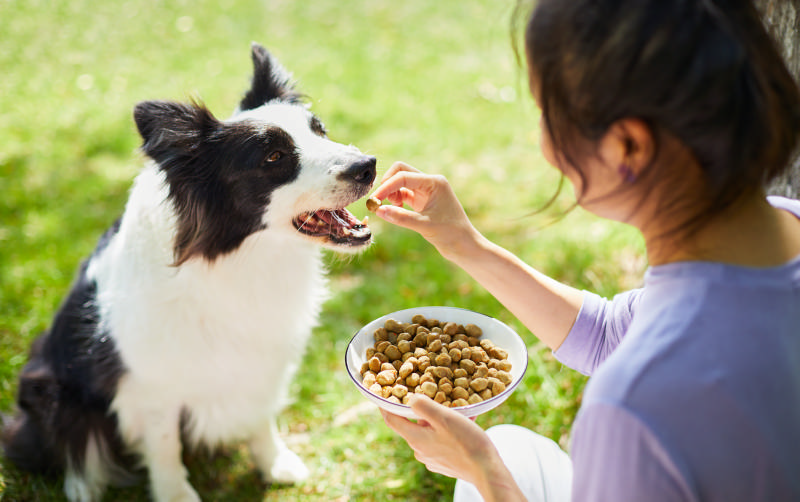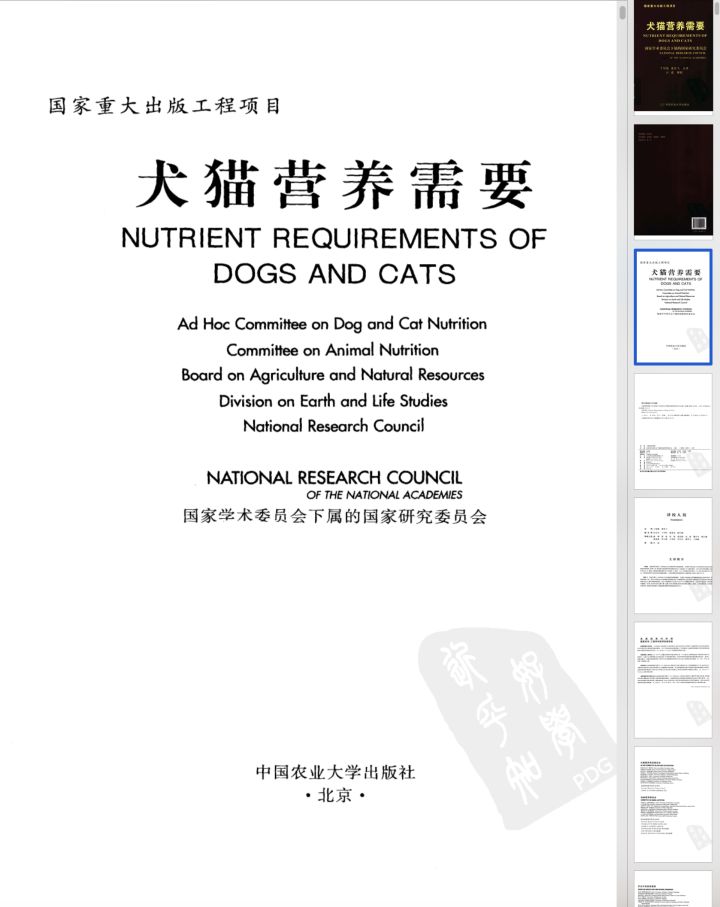猫本来就不爱喝水!营养学家表示宠物鲜粮和生骨肉将会
本文作者:Margaret Gates,是Feline Nutrition Foundation(猫科动物营养基金会)的创始人。
翻译:食物链宠物食品(本文文末附原文)
不让猫以干粮为主食是很重要的。单单这一变化就是改善猫的营养和健康的一大进步。干粮,无论是高端商品粮,处方粮还是“天然粮”,都会损害猫的健康。它主要由淀粉和碳水化合物组成,因此必须通过膨化工艺制成,否则无法挤压成型。配方的营养架构和干粮真的关系不大——因为这不是重点。简单地说,只要是膨化粮,它富含大量碳水化合物并且水份少,就已经违背了猫科动物的进食天性。碳水化合物代替了健康的肉类蛋白质和脂肪,这对于专性食肉动物至关重要。所有这些因素使干粮对猫的健康有害。[1]

干粮的问题是:
水分含量低
高碳水化合物
蛋白质来自植物而非动物
水份含量
猫的食物中必须有水。像鼠类(即猫科的食物)的水分约为65至75%。[2]
猫逐渐从进食的食物中吸收了大部分水分。所以它们不用喝大量的水,也不像狗或人类那样对口渴那么敏感。作为从沙漠中进化而来的生物,猫自然而然会储藏尿液。只吃干粮的猫会喝水,但是很难弥补食物中水分不足的问题,导致尿液更加浓缩。这也是促进猫尿路疾病的元凶。[3]
应当给猫饲喂的水分含量接近其自然猎物饮食的水分:大约65%至80%的水分。猫的生骨肉、罐头、鲜粮等饮食都在此范围内。
高碳水化合物
猫的自然饮食(通常是啮齿动物,兔子,昆虫和鸟类)的碳水化合物含量通常不到2%。猫干粮通常含25-50%的碳水化合物。4这种过量的碳水化合物不仅会促进猫的肥胖,而且还与糖尿病有关。肥胖不会引起糖尿病。相反,肥胖和糖尿病似乎是由同一原因引起的,饮食中碳水化合物过多。[5]
宠物营养学家Lisa A. Pierson表示,“由于缺乏其他哺乳动物中存在的特定酶促途径,猫的碳水化合物利用能力在生理上有所下降,并且它们缺少唾液酶淀粉酶。猫没有饮食上的碳水化合物需求,更令人担忧的是,过多的碳水化合物会严重危害其健康。”[6]
Kymythy R. Schultze表示,“不喂谷物的另一个很好的理由是谷物会分解为体内的糖,这绝对是猫所不需要的!许多研究将糖的摄入与疾病(包括癌症)联系起来。吃高碳水化合物的饮食确实对猫的身体造成了严重破坏。碳水化合物通常被认为是能量食品,但是猫科动物非常有效地利用蛋白质和脂肪来满足这些需求。”[7]
植物蛋白
Lyn Thomson表示,“在商品粮中,产品规定的蛋白质百分比忽略了两个非常重要的因素:
1.如何保证特定蛋白质内富含必需氨基酸?
2.该蛋白质对猫的生物学价值是什么?
蛋白质的生物学价值告诉我们蛋白质对我们的猫有多有益-蛋白质可以多么容易地被猫吸收。换句话说,生物学价值越高,对猫越有用。”
鸡蛋被用作判断所有其他蛋白质的基准。由于其几乎完美的可用性,它们的生物学价值为100。鸡肉的生物学价值为79,牛肉的生物学价值为80。小麦的生物学价值为60,玉米的生物学价值为54。[8] 很容易得出结论,肉类蛋白质对猫的消化率要高于植物蛋白。”
Kymythy R. Schultze:“完整的蛋白质包含大量必需氨基酸,在肉,鱼,蛋和家禽等食物中被发现。不完全的蛋白质不能提供所有必需氨基酸,并且在许多蛋白质中都可以找到。食物,包括豆类,谷物和蔬菜。这些植物蛋白不能提供猫所需的必需氨基酸,例如牛磺酸,它们是来自动物蛋白的。”[9]
不吃干粮的其他原因
干粮不利于猫的牙齿健康。人们喜欢认为干粮有助于清洁猫的牙齿,但事实恰恰相反。 Guillermo Díaz博士说:“干粮一样形状通常很小,这使得猫很难咀嚼,因此它们可能直接吞下整个颗粒。对表面的抛光效果为零此外,当与唾液接触时,颗粒中的高含量碳水化合物或多糖会释放出来并粘附在牙齿表面,从而导致牙垢和牙周病形成的第一阶段:牙菌斑。”[10]
最初生产出来的干粮对猫来说不会有任何兴趣[11],必须喷上诱食剂、风味剂及其伴随的气味,才能让猫对进食感兴趣。
干粮可能会因谷物储存不当而受到霉菌,真菌或霉菌毒素的污染。[12] 由于干粮不太可能由最高品质的谷物制成-也许是不适合人类食用的谷物-这是一个进一步的问题。干粮绝对不能用水润湿,因为它会形成微生物理想的“温床”,使霉菌毒素在其中扩散。
召回涉及沙门氏菌污染的宠物食品通常是宠物干粮。[13]干粮比未加工的猫食更危险,因为人们对其处理并不谨慎。
参考资料
1. J. S. Rand, L. M. Fleeman, H. A. Farrow, D. J. Appleton, and R. Lederer, "Canine and Feline Diabetes Mellitus: Nature or Nurture?," The Journal of Nutrition, August 2004.
Peter J. Markwell, C. Tony Buffington, and Brigitte H. E. Smith, "The Effect of Diet on Lower Urinary Tract Diseases in Cats," The Journal of Nutrition 128, no. 12, December 1998, 2753S-2757S.
2. Ellen S. Dierenfeld, PhD, Heather L. Alcorn, BS, and Krista L. Jacobsen, MS, "Nutrient Composition of Whole Vertebrate Prey (Excluding Fish) Fed in Zoos," 2002.
3. Peter J. Markwell, C. Tony Buffington, and Brigitte H. E. Smith, "The Effect of Diet on Lower Urinary Tract Diseases in Cats," The Journal of Nutrition 128, no. 12, December 1998, 2753S-2757S
4. Michael S. Hand, DVM, PhD; Craig D. Thatcher, DVM, MS, PhD, Rebecca L. Remillard, PhD, DVM, and Philip Roudebush, DVM, Small Animal Clinical Nutrition, 4th ed. Walsworth Publishing Company, 2000, 1075, 1077.
5. J. S. Rand, L. M. Fleeman, H. A. Farrow, D. J. Appleton, and R. Lederer, "Canine and Feline Diabetes Mellitus: Nature or Nurture?," The Journal of Nutrition, August 2004.
Susan Donoghue and Janet M. Scarlett, "Diet and Feline Obesity," The Journal of Nutrition 128, no. 12, December 1998, 2776S-2778S.
6. Lisa A. Pierson, DVM, "We Are Feeding Cats Too Many Carbohydrates."
7. Kymythy R. Schultze, CN, CNC, Natural Nutrition for Cats, Hay House, Inc., 2008, 29.
8. JG Morris, "Idiosyncratic Nutrient Requirements of Cats Appear to be Diet-induced Evolutionary Adaptations," Nutrition Research Reviews 15, no. 1, June 2002, 153-68.
9. Kymythy R. Schultze, CN, CNC, Natural Nutrition for Cats, Hay House, Inc., 2008, 23.
10. C Zambori, E Tirziu, I Nichita, C Cumpanasoiu, RV Gros, M Seres, B Mladin and D Mot, "Biofilm Implication in Oral Diseases of Dogs and Cats," Scientific Papers: Animal Science and Biotechnologies 45, no. 2, 2012.
11. Christopher S. Cowell, Neil P. Stout, Mark F. Brinkman, Edward A. Moser, and Stephen W. Crane, "History of Pet Food Manufacture in the United States," Small Animal Clinical Nutrition, 4th ed. Walsworth Publishing Company, 2000, 132-134.
12. Maxwell C. K. Leung, Gabriel Díaz-Llano, and Trevor K. Smith, "Mycotoxins in Pet Food: A Review on Worldwide Prevalence and Preventative Strategies," Journal of Agricultural and Food Chemistry 54, 2006, 9623-9635.
13. "Update: Recall of Dry Dog and Cat Food Products Associated with Human Salmonella Schwarzengrund Infections – United States, 2008," Morbidity and Mortality Weekly Report, Centers for Disease Control, November 7, 2008.
以下为原版文章
Bio-Inappropriate: The Dangers of Dry Cat Food
"I have never seen a single case of serious obesity, diabetes, urinary tract disease, or IBD in a cat fed meat instead of commercial dry foods. Many other people have seen the same results. Further, I do not see nutritional deficiencies in cats fed properly balanced raw-meat diets. I want to emphasize a point here. The incidence of these problems has not just declined on a raw-meat diet, they have entirely disappeared. These results are too dramatic to ignore."
Elizabeth Hodgkins, DVM, from Your Cat: Simple New Secrets to a Longer, Stronger Life.
It is important to remove dry food from your cat's diet. This one change alone is a big step forward in improving cat nutrition and health. Dry food, be it premium, prescription or "natural," harms your cat's health. It consists mostly of starch and carbohydrates – it must be, as it can't be manufactured and extruded otherwise. The quality of the ingredients really doesn't matter – that's not the point. Simply that it is carb-laden and dry is enough to make it a terrible choice for cats. The carbs take the place of healthy meat-derived protein and fats that are vital for an obligate carnivore. All of these factors make dry foods detrimental to health.¹
The problems with dry food are:
Low moisture content
High in carbohydrates
Protein from plant rather than animal sources
Moisture Content
Cats must have water in their food. A mouse is about 65 to 75% moisture.²
Cats evolved getting most of their fluid intake from the foods they ate. They don't drink a lot of water and don't have the thirst drive that dogs or humans have. As creatures that evolved in the desert, they naturally concentrate their urine. A cat getting only dry foods will drink water, but will have a hard time making up for the lack of moisture in the food, leading to even more concentrated urine. This can promote feline lower urinary tract disease.³
Cats should be fed a diet with a moisture content that is close to what their natural prey diet would be: around 65 to 80 percent moisture. A raw cat food or a canned diet both are in this range. For more information on this, see "Answers: What Dry Food Does to Your Cat's Pee."
High in Carbohydrate
A cat's natural diet, usually rodents, rabbits, insects and birds, is usually less than 2% carbohydrate. Dry cat food is generally 25-50% carbohydrate.4 Not only does this excess carbohydrate promote obesity in cats, but it's also implicated in diabetes. Obesity doesn't cause diabetes. Rather, obesity and diabetes appear to have the same cause, too much carbohydrate in the diet.5
From Lisa A. Pierson, DVM: "Cats have a physiological decrease in the ability to utilize carbohydrates due to the lack of specific enzymatic pathways that are present in other mammals, and they lack a salivary enzyme calledamylase. Cats have no dietary need for carbohydrates and, more worrisome is the fact that too many carbohydrates can be highly detrimental to their health."6
From Kymythy R. Schultze, CN, CNC: "Another good reason not to feed grain is the fact that it breaks down into sugar within the body something a cat definitely doesn't need! Many studies link sugar consumption to illness, including cancer. Eating a high-carb diet really wreaks havoc on a cat's body. Carbs are usually thought of as energy foods, but felines utilize protein and fat very efficiently for those needs."7
Protein From Plant Sources
From Lyn Thomson, BVSc: "In commercial cat food, a product's stated protein percentage can ignore two very important factors:
How packed full of essential amino acids is that particular protein source?
What is the biological value of that protein to the cat?
The biological value of the protein tells us how beneficial that protein is to our cats – how readily that protein can be utilised by the cat. In other words, the higher the biological value, the more usable it is to the cat.
Chicken eggs are used as a benchmark by which all other proteins are judged. They have a biological value of 100 – due to their near perfect usability. The biological value of chicken is 79, beef is 80. The biological value of wheat is 60, and of corn is 54.⁸ It is easy to conclude that meat proteins will have a higher digestibility for cats than plant proteins."
From Kymythy R. Schultze, CN, CNC: "Complete proteins contain ample amounts of essential amino acids and are found in foods such as meat, fish, eggs, and poultry. Incomplete proteins do not provide all essential amino acids and are found in many foods, including legumes, grains, and vegetables. These plant proteins don't provide the essential amino acids that a cat needs, such as taurine, which come from animal protein."⁹
A Few Other Reasons to Avoid Dry Cat Food
Dry foods are not good for your cat's dental health. People like to think that dry foods help clean a cat's teeth, but the opposite is true. According to Dr. Guillermo Díaz, MV: "The shape of the kibble is generally small in size which makes it very difficult for a cat to chew on, so they generally swallow the whole pellet as presented. This has zero polishing effect on the surface of the teeth. Moreover, when in contact with the saliva, the high content of carbohydrates, or polysaccharides, in the pellet is released and adheres on the surface of the teeth causing the first stage in the formation of tartar and periodontal disease: the formation of dental plaque."10 For much more on this, check out "Answers: What Dry Food Does to Your Cat's Teeth."
Dry food as it is initially manufactured would be of no interest to a cat. It must be sprayed with flavorings and their accompanying odors to interest the cat in eating it.¹¹ An entire industry has arisen to manufacture such sprays for this biologically-inappropriate food product.
Dry food can be contaminated with mold, fungus or mycotoxins due to improper grain storage.¹² As kibble is unlikely to be made from the highest quality grain – perhaps grain not fit for human consumption – it is a further concern. Dry food should never be moistened with water, as it creates an ideal soup in which mycotoxins can proliferate. Read "Answers: One More Reason to Ditch Dry Food."
Pet food recalls involving salmonella contamination are commonly for dry pet food.13 Dry food can be more dangerous than raw cat food because people are not cautious about handling it. With raw food for cats, safe handling and feeding practices are followed, so contamination is unlikely.
Margaret Gates is the founder of the Feline Nutrition Foundation.
关于犬猫营养学还有待进一步探索,对营养研究有兴趣的童鞋可以私信【犬猫营养】获取中国农业大学出版社出版的《犬猫营养需要》电子书pdf~也欢迎与我们一起探讨~
希望所有宠物都能吃得好一点,陪伴我们久一点。

小佩宠物( www.petkit.cn )综合整理,若需引用或转载,请注明出处 ,仅供参考、交流之目的。





